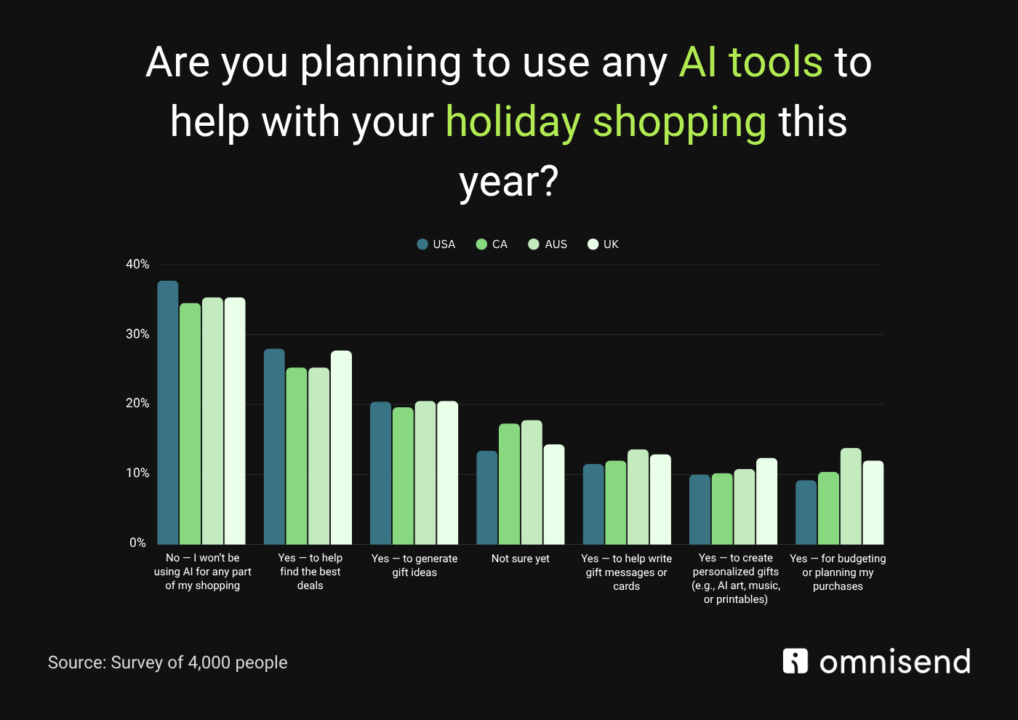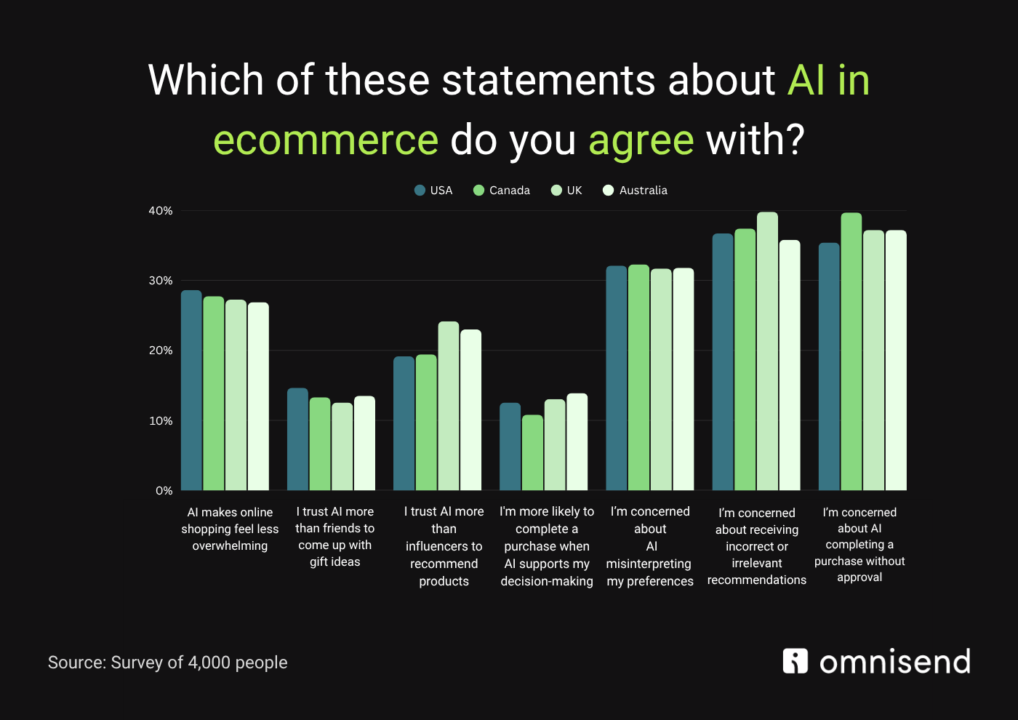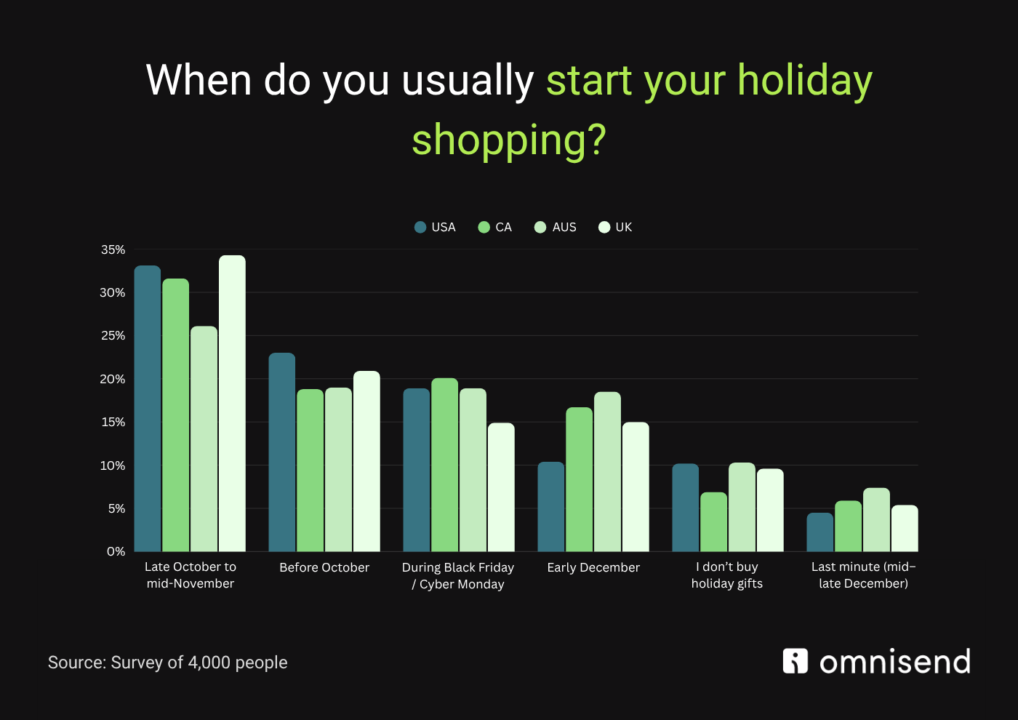Drive sales on autopilot with ecommerce-focused features
See FeaturesThe last time we checked in on AI and ecommerce, about half of online shoppers across the US, the UK, Canada, and Australia were already using AI for small everyday stuff — finding products, spotting deals, cleaning up messy shopping lists.
Which was cool, but not exactly surprising.
Fast-forward to the holidays, and suddenly AI is invited to a lot more of the party. This time, it’s involved in the actual shopping decisions.
So we looked at how 4,000 shoppers across those four countries plan to use AI this season. Here’s what came out of it.
Holiday habits at a glance
Across all four countries, AI is becoming a very normal part of holiday shopping:
- 81% plan to use AI for at least one shopping task
- 68% are comfortable with AI completing a purchase
- 13% say they’re more likely to buy with AI support
- 14% trust AI-generated gift ideas more than their friends
- 11% will use AI specifically to plan and budget
- 37% worry AI might misread their tastes
- 37% expect irrelevant recommendations
In other words: AI is welcome, but it still has to earn its place.
From inspiration to checkout, AI is along for the entire holiday journey
Yes, AI isn’t just for quick searches anymore. It’s helping people from the moment they start looking for ideas to the moment they hit “place order.”
In the past six months alone, many shoppers have already used AI to come up with gift ideas: 28% in the US, 21% in the UK, 18% in Canada, and 20% in Australia.
And looking ahead to the holidays, those numbers jump even higher. About 79% of US shoppers, 86% in the UK, 78% in Canada, and 84% in Australia plan to use AI for something this season — finding deals, comparing products, writing gift messages, budgeting, or creating personalised gifts like music, art, or printables.

People are also getting much more relaxed about checkout. Only 32% across all four countries feel uneasy about AI completing a purchase. Last year, that number was 66% in the US alone. So, something clearly shifted.
There’s also a tiny but loud group of shoppers who trust AI’s taste more than their friends. Around 15% say AI gives better gift ideas, and between 19–24% say AI product recommendations beat influencers.
Of course, AI still has its limits. Between 37–40% worry it won’t “get” their preferences, and 35–40% expect irrelevant recommendations entirely.

Why shoppers are turning to AI this season
Let’s get real here – holiday shopping comes with enough pressure on its own. So it makes sense that shoppers are turning to AI for help.
In fact, 29% in the US, 27% in the UK, 28% in Canada, and 27% in Australia state that AI makes online shopping feel less overwhelming.
But holiday stress isn’t the only thing pushing people toward AI this year. Economic pressure is playing a role too. Between job uncertainty, tariffs, and higher living costs, shoppers are being more cautious.
That explains why 75% of US shoppers, 70% in the UK, 71% in Canada, and 64% in Australia plan to shop early — well before the usual October–Cyber Monday window.

Budgets tell the same story. Around 78% of US shoppers, 71% in the UK, 76% in Canada, and 81% in Australia want to spend less than last year.
Because of this, it’s not surprising that some shoppers are using AI for very practical support: keeping track of budgets and helping with planning. That’s 9% in the US, 12% in the UK, 10% in Canada, and 14% in Australia.
And when even that isn’t enough, there’s BNPL (Buy Now, Pay Later). It appears that 18% of respondents in the US, 15% in the UK, 11% in Canada, and 19% in Australia say they may use it for gifts this year.
“Combine holiday expectations with higher prices, trade pressures, and job insecurity, and you get a perfect storm of financial anxiety, to which AI is a relatively easy solution,” says Marty Bauer, Ecommerce Expert at Omnisend.
“Comparing options faster and sticking to a budget are just some of the ways AI tools can turn a chaotic, emotional process into a more structured one. It might not remove the stress, but you still end up feeling more in control.”
So no – people aren’t turning to AI for some kind of novelty. They’re using it because it takes some of the pressure out of holiday shopping.
What this means for brands
People are still shopping. Still buying gifts. They’re just doing it differently.
They’re comparing more, trying to spend less, and relying on AI to help them make reasonable choices. And honestly… fair enough.
For brands, this means a few things:
- Make value obvious
- Expect comparison shopping
- Keep friction low
- Support budgeting, not impulse
- Avoid overcomplicating things — nobody’s in the mood for that
Overall, this holiday season isn’t about indulgence. It’s about getting through the list without any unnecessary stress – with AI stepping in where it helps.
Methodology
This research draws on findings from two surveys commissioned by Omnisend and conducted by Cint in July 2025. The first survey focused on AI-assisted shopping and included 1,224 U.S. consumers. The second focused on holiday shopping behavior and included 1,200 U.S. adults. In both surveys, quotas were placed on age, gender, and place of residence to achieve a nationally representative sample of U.S. users.
Want to dive deeper into the data?
Reach out to [email protected] for media inquiries or interviews.
TABLE OF CONTENTS
TABLE OF CONTENTS


No fluff, no spam, no corporate filler. Just a friendly letter, twice a month.

 OFFER
OFFER







